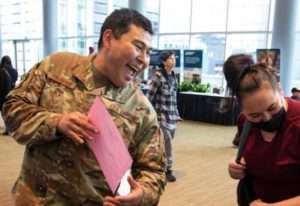
JOINT BASE ELMENDORF-RICHARDSON, Alaska — In a cabin nine miles from his home village of White Mountain, Alaska, Tech. Sgt. Blassi Shoogukwruk, a C-17 Globemaster III crew chief with the Alaska Air National Guard’s 176th Aircraft Maintenance Squadron took his first ride in a UH-1 Huey helicopter at the tender age of three.
Not many people get to experience a free ride in a helicopter. However, for Shoogukwruk and his family, it was no joy ride. The helicopter came to rescue the family after a spring-time flood inundated their cabin.
“I was the first one awake, and I saw an empty coffee can floating on the floor by my bed,” he recalls. “After I saw that, I woke everyone else up and my dad got us out of the cabin.”
After learning their boat had a hole in it, Shoogukwruk’s father led everyone to a floating ice sheet to wait for their rescue. Twenty minutes later, the helicopter and its crew arrived and transported the family back to White Mountain. The Airman remembers it like it was yesterday.
“It was one of my first memories,” he said.
It was that core memory that inspired Shoogukwruk to walk into an Alaska National Guard recruiting office in February 2005 while he was taking a break from college at University of Alaska – Fairbanks.
He spoke to an HC-130 rescue pilot, who shared what the Air National Guard had to offer. After a rigorous enlistment process, he enlisted as a rescue HC-130P/N Combat King crew chief in February 2006.
“Rescue was something I always wanted to be a part of because I wanted to give back,” he said. “The Alaska Air National Guard really sold itself to me that day.”
In 2010, he landed his first active, full-time position working with C-17s and has alternated assignments between the two airframes ever since. Throughout his career, he has gained experience working in maintenance operations, airlift, cargo and rescue operations.
Shoogukwruk isn’t the first in his family to step forward and serve his community, state and nation. He comes from a tradition of military service, with both grandfathers serving with the Alaska Territorial Guard and his mother serving as one of the first female Army Guardsmen in Alaska villages.
He also has uncles that served in the Alaska Army National Guard, Navy and Marine Corps. However, he is the first in his family to serve in the Air Force.
The pride in his family’s military service came easily, but when it came to accepting his heritage, the Siberian Yupik, Inupiaq, and Athabascan Native said it hasn’t always been easy. As a child growing up in a small Alaskan village, he became well aware of what previous generations of Native Americans endured in their history.
Shoogukwruk’s parents grew up in a generation of Native Americans that were punished for speaking their language in school, which caused them to struggle with their Alaska Native identities. He said his parents’ experiences played a part in shaping his own view of himself.
“At first, when you walk into a room, you say to yourself ‘Oh no, they’re going to see that I’m Native and maybe they won’t like me because of it,’” he explained. “But going through college and learning that I am who I am because I was meant to be has helped.”
It was while attending a college with mostly Native American students for a year that Shoogukwruk fully embraced his identity.
“Being Alaska Native and living in this land brings me huge amounts of pride,” he said. “My mom always told us the people we came from are super strong people, so just knowing where I came from reaffirms my pride in my heritage.”
His connection to his Alaska Native heritage continues to play an important role in his military career. When remnants of Typhoon Merbok hit Western Alaska villages in September, Shoogukwruk knew it was his turn to serve his community.
After volunteering to go on state active duty, he was assigned to Task Force Nome, which was responsible for initial clean up, making emergency repairs and assisting communities with damage assessments in storm-affected communities across Western Alaska.
He spent seven days in Golovin, a community of people he grew up with, just 15 miles from his home village.
“When the storms happened, they literally and figuratively hit home,” he said. “Just being able to go back, give back to a place where I grew up and show representation was a huge honor for me.”
November is National Native American Heritage month, which celebrates the history and traditions of Native American people and their tribes.
A significant part of Native American history for Alaska includes the service of the Alaska Territorial Guard, where thousands of Alaska Natives from more than 100 communities served during World War II as a defense against potential Japanese invasion along the 6,640-mile Alaskan coastline.
Today, Shoogukwruk continues the story of proud Alaska Native service, just like his mother, grandfathers and other Alaska National Guardsmen before him.
“With a lot of us Native people that serve, we’re not just serving our country. This is our home,” he said. “I’m not just serving my country, I’m serving my home, and I’m defending my home.”
###
